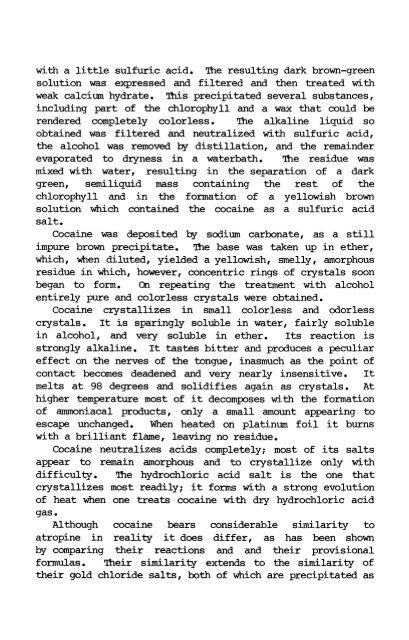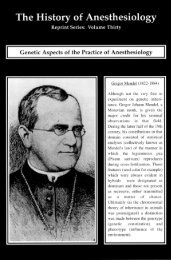Download PDF - Wood Library-Museum of Anesthesiology
Download PDF - Wood Library-Museum of Anesthesiology
Download PDF - Wood Library-Museum of Anesthesiology
Create successful ePaper yourself
Turn your PDF publications into a flip-book with our unique Google optimized e-Paper software.
with a little sulfuric acid. The resulting dark brown-greensolution was expressed and filtered and then treated withweak calcium hydrate. This precipitated several substances,including part <strong>of</strong> the chlorophyll and a wax that could berendered completely colorless. The alkaline liquid soobtained was filtered and neutralized with sulfuric acid,the alcohol was removed by distillation, and the remainderevaporated to dryness in a waterbath. The residue wasmixed with water, resulting in the separation <strong>of</strong> a darkgreen, semiliquid mass containing the rest <strong>of</strong> thechlorophyll and in the formation <strong>of</strong> a yellowish brownsolution which contained the cocaine as a sulfuric acidsalt.Cocaine was deposited by sodium carbonate, as a stillimpure brown precipitate. The base was taken up in ether,which, when diluted, yielded a yellowish, smelly, amorphousresidue in which, however, concentric rings <strong>of</strong> crystals soonbegan to form. On repeating the treatment with alcoholentirely pure and colorless crystals were obtained.Cocaine crystallizes in small colorless and odorlesscrystals. It is sparingly soluble in water, fairly solublein alcohol, and very soluble in ether. Its reaction isstrongly alkaline. It tastes bitter and produces a peculiareffect on the nerves <strong>of</strong> the tongue, inasmuch as the point <strong>of</strong>contact becomes deadened and very nearly insensitive. Itmelts at 98 degrees and solidifies again as crystals. Athigher temperature most <strong>of</strong> it decomposes with the formation<strong>of</strong> ammoniacal products, only a small amount appearing toescape unchanged. When heated on platinum foil it burnswith a brilliant flame, leaving no residue.Cocaine neutralizes acids completely; most <strong>of</strong> its saltsappear to remain amorphous and to crystallize only withdifficulty. The hydrochloric acid salt is the one thatcrystallizes most readily; it forms with a strong evolution<strong>of</strong> heat when one treats cocaine with dry hydrochloric acidgas.Although cocaine bears considerable similarity toatropine in reality it does differ, as has been shownby comparing their reactions and and their provisionalformulas. Their similarity extends to the similarity <strong>of</strong>their gold chloride salts, both <strong>of</strong> which are precipitated as
















